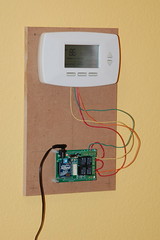Since I started eating my own dog food (but more about that later), I've met with the same problem many of other DZ users already have: the fact that system is not quite that accessible. Easy to control, yes, but not accessible. You can't just push a button passing by the thermostat in the hallway.
And the worst situation you may find yourself in is when you're asleep or away, and someone in the house wants things warmer or colder. Oh no, you don't want that (yeah, and that tooth had to be removed anyway).
But there is a solution.

Granted, totally ugly, but totally dependable.
How It Works
When you connect the relay board, you connect it not directly to HVAC cable or the unit itself, but as a piggyback to an existing thermostat. Let's consider RTH7500 (above) as an example.
Determine Wiring Scheme
Find the manual for your thermostat (here's a link to
RTH7500 manual). Find the diagram for your specific installation (mine is on page 10, "Connect wires: Heat Pump").
Thus, you now know what wires to connect. For the example above I needed red, orange, yellow and green.
Careful! your HVAC installer may have used different colors, you have to look at the markings, not at the wire color!
Get yourself a piece of
thermostat cable, or just find appropriate wires.
Connect the relay board
Red wire is the common wire, connect it to all "common" contacts. Connect other wires
as appropriate.Caveats
There are two common thermostat connection schemes - (white and yellow) vs. (yellow or white and orange) or (yellow or white and blue). Orange and blue wires are mode selectors - you need to know which exactly is the scheme your thermostat uses. For example, RTH7500 uses yellow plus orange ("energize to cool") and I connected it to NC contacts, since most of the year the thermostat is in cooling mode. Your mileage may vary.
Congratulations, you're done
So how does all this help you? Simple.
First of all, you set the thermostat much higher (assuming cooling mode) than it is necessary (if you take a look at the
big picture, you'll see that the thermostat is set to 90°F) and set it to permanent hold. Then when you're not around and there is a desperate need to change settings, all that needs to be done is
- Press the "Use Schedule" button (or the equivalent);
- (optional) Disconnect the power to the relay board.
Added benefit is that whenever anyone is compelled to do so, the home climate will return to abominable state it was before, and the temptation will disappear for a long time.
PS: I am working on a more permanent solution, right now.



